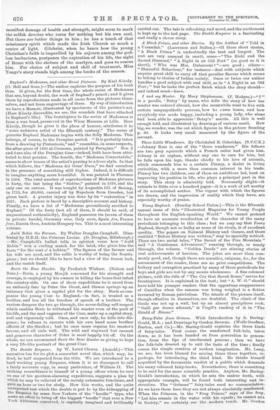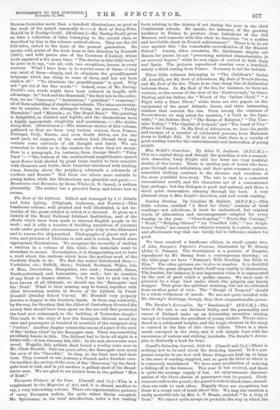Fairy-Tales from Grimm. With Introduction by S. Baring- Gould, M.A.;
and Drawings by Gordon Browne. (Wells Gardner, Darton, and Co.)—Mr. Baring-Gould explains the three kinds of fairy-tales. First comes the unadorned folk-tale, taken down, as it has been handed on from generation to genera- tion, from the lips ef uneducated persons ; then we have the folk-tale dressed up to suit the taste of the time ; finally comes the simple creation of modern imagination. Mr. Lang, we see, has been blamed for mixing these three together, or, perhaps, for introducing the third kind. He thinks himself acquitted by the favourable verdict of a publics which demands his many coloured fairy-books. Nevertheless, there is something to be said for the more scientific practice. Anyhow, Mr. Baring- Gould's introduction, in which be sets the matter forth, with appropriate example, will be found both interesting and in- structive. The "Grimm" fairy-tales need no commendation. As we have them here they are not always absolutely unadorned. When the Princess, in the "Frog Prince," says of the frog, "Let him remain in the water with his equals ; he cannot mix in Society," we certainly see the modern touch. Mr. Gordon Browne furnishes more than a hundred illustrations, as good as the work of his pencil commonly is.--A Book of Fairy-Tales. Retold by S. Baring-Gould. (Mothuen.)—Mr. Baring-Gould gives us here a collection of tales belonging to the second class, as described by him in the volume noticed above. They are the old folk-tales, suited to the taste of the present generation. He speaks with praise of the work done in this direction by Perrault (1697), and with praise also of the Countess d'Aulnoy, whose work appeared a few years later. "The stories in this little book," he goes on to say, "are all, with two exceptions, known in every nursery. What I have done is to rewrite some of them—I may say, most of them—simply, and to eliminate the grandiloquent language which has clung to some of them, and has not been shaken off." "To eliminate the grandiloquent" is good. Why not "get rid of the fine words " ? Indeed, some of Mr. Baring- Gould's own words might have been reduced in length, with advantage. In "Jack and the Beanstalk," the first tale in the collec- tion, we see "lonesome," "destitution," "gratified," "voracious," all of them admitting of simpler equivalents. The tales are twenty- one in number, the two strangers being, we presume, "Pretty Marushka " and " Miranda ; or, The Royal Race." The printing is delightful, so distinct and legible, and the illustrations have a highly appropriate simplicity and quaintness.—The Golden Fairy-Book. (Hutchineon.)—The nineteen stories of this volume, gathered as they are from very various sources, from France, Portugal, Italy, Russia, and even South Africa, are for the most part, we suppose, of the modern kind, though they may contain some survivals of old thought and fancy. We are somewhat in doubt as to the readers for whom they are meant. Here is a paragraph, for instance, from George Sand's "Fairy Dust " :—" The bottom of the architectural amphitheatre opened upon flower beds shaded by giant trees, loaded to their summits with blossoms and fruits, their branches interlaced with trailing vines, forming above the porphyry colonnade a colonnade of verdure and flowers." But there are others more suitable to young tastes, while the illustrations are plentiful and good. Moonbeams and Brownies, by Roma White (A. D. lanes), is written pleasantly. The author has a graceful fancy, and knows how to amuse,



















































 Previous page
Previous page